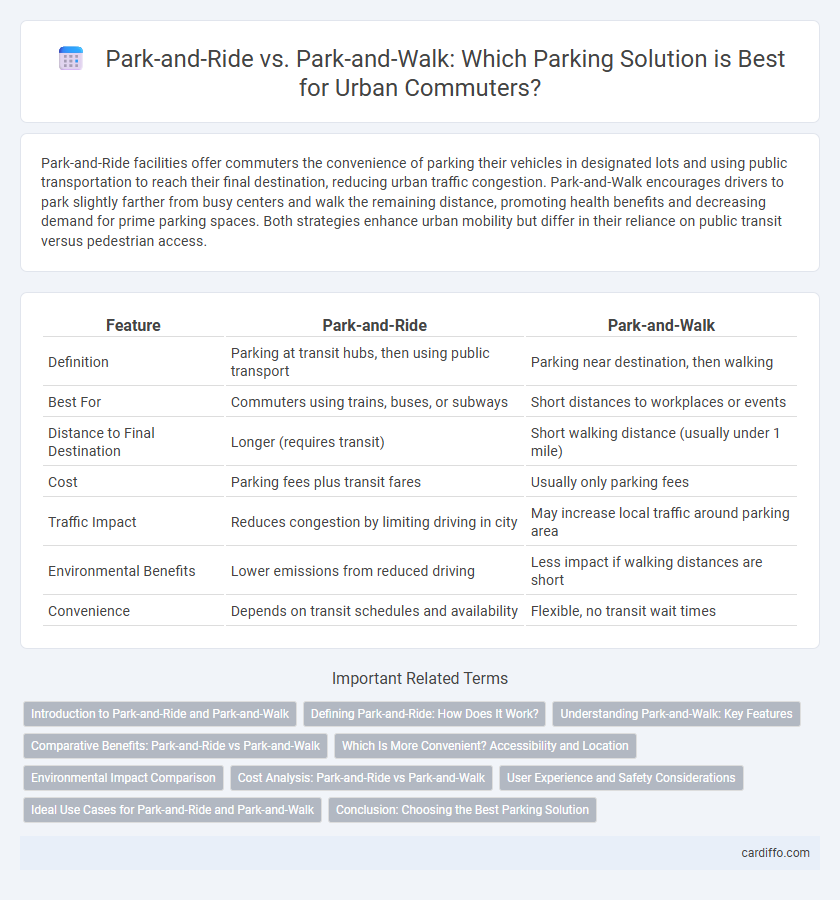Park-and-Ride facilities offer commuters the convenience of parking their vehicles in designated lots and using public transportation to reach their final destination, reducing urban traffic congestion. Park-and-Walk encourages drivers to park slightly farther from busy centers and walk the remaining distance, promoting health benefits and decreasing demand for prime parking spaces. Both strategies enhance urban mobility but differ in their reliance on public transit versus pedestrian access.
Table of Comparison
| Feature | Park-and-Ride | Park-and-Walk |
|---|---|---|
| Definition | Parking at transit hubs, then using public transport | Parking near destination, then walking |
| Best For | Commuters using trains, buses, or subways | Short distances to workplaces or events |
| Distance to Final Destination | Longer (requires transit) | Short walking distance (usually under 1 mile) |
| Cost | Parking fees plus transit fares | Usually only parking fees |
| Traffic Impact | Reduces congestion by limiting driving in city | May increase local traffic around parking area |
| Environmental Benefits | Lower emissions from reduced driving | Less impact if walking distances are short |
| Convenience | Depends on transit schedules and availability | Flexible, no transit wait times |
Introduction to Park-and-Ride and Park-and-Walk
Park-and-Ride is a parking strategy where commuters park their vehicles in designated lots on the outskirts of urban areas and use public transportation to reach their final destinations. Park-and-Walk involves parking close to the destination and walking the remaining distance, often used in downtown or congested areas where parking is limited. Both methods aim to reduce traffic congestion and decrease the environmental impact of commuting by encouraging partial use of public transit or walking.
Defining Park-and-Ride: How Does It Work?
Park-and-Ride systems provide designated parking lots near transit hubs where commuters can park their vehicles and transfer to public transportation, reducing urban traffic congestion. These facilities are strategically located to facilitate seamless connections to buses, trains, or subways, enhancing the convenience of multimodal travel. Park-and-Ride encourages sustainable commuting by minimizing downtown parking demand and lowering carbon emissions.
Understanding Park-and-Walk: Key Features
Park-and-Walk involves parking a vehicle in designated areas near urban centers or transit hubs and walking to the final destination, promoting convenience and reducing congestion. Key features include strategically located parking lots, pedestrian-friendly pathways, and proximity to commercial, office, or recreational areas. This approach supports sustainable urban mobility by integrating walking with parking, enhancing accessibility without relying solely on transit connections.
Comparative Benefits: Park-and-Ride vs Park-and-Walk
Park-and-Ride facilities offer the advantage of reducing inner-city traffic congestion by enabling commuters to park on the outskirts and use public transit, which also lowers urban emissions significantly. In contrast, Park-and-Walk promotes healthier lifestyle choices and supports local businesses by encouraging short walking distances, ideal for neighborhoods with accessible amenities. Both approaches optimize parking efficiency but differ in environmental impact and community engagement, with Park-and-Ride favoring mass transit integration and Park-and-Walk enhancing pedestrian infrastructure.
Which Is More Convenient? Accessibility and Location
Park-and-Ride facilities are typically located near transit hubs, offering convenient access to public transportation, which reduces the need for lengthy walking distances and provides smooth connectivity for commuters. Park-and-Walk options generally serve destinations within walking distance, ideal for short trips or areas with limited transit availability but can be less convenient for long-distance travelers. Accessibility depends on the user's needs: Park-and-Ride maximizes convenience for daily commuters using transit systems, while Park-and-Walk suits those prioritizing proximity and direct access to specific locations.
Environmental Impact Comparison
Park-and-Ride systems significantly reduce urban congestion and lower greenhouse gas emissions by encouraging commuters to park outside city centers and use public transportation, leading to fewer vehicles on congested roads. Park-and-Walk, while promoting physical activity and reducing short-distance vehicle use, typically results in higher local emissions due to continued reliance on private cars for the entire trip. Studies show that Park-and-Ride has a more substantial positive environmental impact by minimizing total vehicle miles traveled and improving overall air quality in metropolitan areas.
Cost Analysis: Park-and-Ride vs Park-and-Walk
Park-and-ride systems generally offer lower overall transportation costs by combining affordable parking fees with reduced fuel and vehicle wear expenses, benefiting commuters traveling longer distances. In contrast, park-and-walk often involves higher parking costs due to urban location premiums, though it eliminates transit fares and can save time for short-distance travel. Evaluating cost efficiency depends on factors such as parking pricing structures, commuting distance, and available public transit options.
User Experience and Safety Considerations
Park-and-Ride facilities enhance user experience by offering secure, well-lit parking lots with direct shuttle services to transit hubs, reducing walking distance and exposure to traffic hazards. Park-and-Walk options provide convenience for short-term parking close to destinations but may involve navigating through less controlled pedestrian zones, potentially increasing safety risks. Effective design of both schemes prioritizes clear signage, surveillance systems, and accessibility features to optimize user safety and comfort.
Ideal Use Cases for Park-and-Ride and Park-and-Walk
Park-and-Ride is ideal for commuters traveling from suburban or rural areas to urban centers, combining driving with public transit to reduce downtown traffic congestion and parking demand. Park-and-Walk suits urban dwellers or visitors who prefer parking in lots or garages within walking distance of busy commercial areas, event venues, or transit hubs where direct access is limited. Both strategies optimize parking efficiency while supporting sustainable urban mobility and reducing environmental impact.
Conclusion: Choosing the Best Parking Solution
Park-and-Ride offers convenience and cost savings for commuters utilizing public transit, reducing urban congestion and emissions. Park-and-Walk suits shorter trips or areas with limited transit access, promoting physical activity and flexibility. Selecting the best parking solution depends on travel distance, transit availability, and personal preferences, balancing efficiency with environmental impact.
Park-and-Ride vs Park-and-Walk Infographic

 cardiffo.com
cardiffo.com